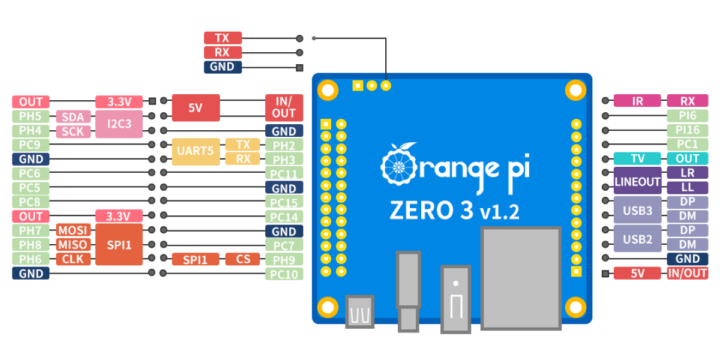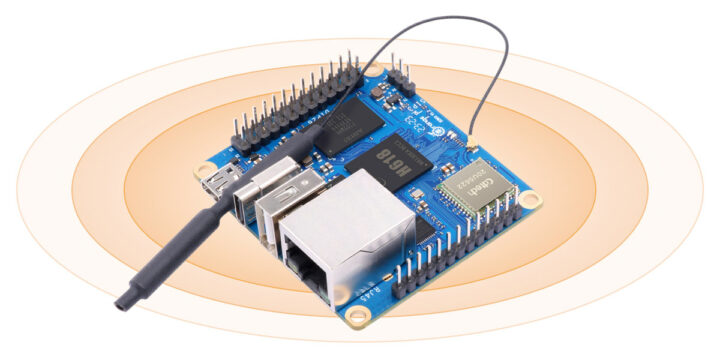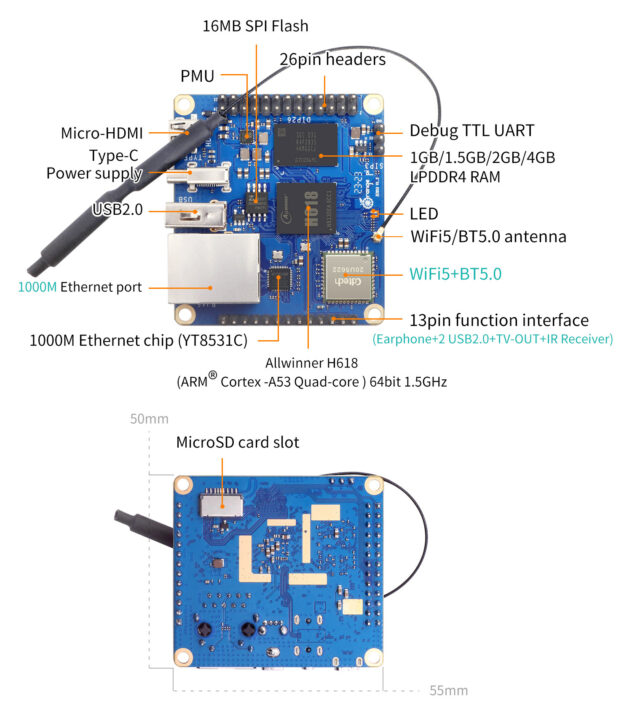The Orange Pi Zero 3 is a compact Allwinner H618 quad-core Arm Cortex-A53 SBC with 1GB to 4GB RAM, 16MB SPI flash, micro HDMI output, Gigabit Ethernet, WiFi 5 and Bluetooth 5.0, a USB 2.0 port, and two headers for expansion.
It provides an update to the Allwinner H616-powered Orange Pi Zero 2 SBC quadrupling the maximum memory to 4GB and embedding a larger SPI flash. The new board basically offers the same ports but in a different layout and a slightly smaller form factor.
Orange Pi Zero 3 specifications:
- SoC – Allwinner H618 quad-core Arm Cortex-A53 processor @ up to 1.5GHz with 1MB L2 cache and Arm Mali-G31 MP2 GPU with support for OpenGL ES 1.0/2.0/3.2, OpenCL 2.0, Vulkan 1.1
- System Memory – 1GB, 1.5GB, 2GB, or 4GB LPDDR4
- Storage – 16MB SPI flash, microSD card socket
- Video Output
- Micro HDMI 2.0 up to 4Kp60
- Video composite (CVBS) via 13-pin header
- VPU
- VP9-10 Profile-2 up to 6Kp30
- H.265 HEVC MP-10 @ L5.1 up to 6Kp30
- H.264 AVC HP @ L5.1 up to 4Kp30
- H.264 MVC up to 1080p60
- Audio
- Digital audio output via HDMI
- 2-ch output, 1-ch input via 13-pin header
- Connectivity
- Gigabit Ethernet RJ45 port via YT8531C PHY
- Dual-band WiFi 5 and Bluetooth 5.0 (CdTech 20U5622 module) with external antenna
- USB – 1x USB 2.0 Type-A port, 2x USB 2.0 interfaces on 13-pin header
- Expansions
- 26-pin GPIO header with I2C, SPI, UART, GPIOs
- 13-pin GPIO header with audio, 2x USB 2.0, TV out, and IR receiver
- Debugging – 3-pin debug UART
- Power Supply – 5V/3A via USB Type-C port
- Dimensions – 55 x 50 mm

The main difference between Allwinner H616 and Allwinner H618 is that the latter comes with 1MB L2 cache for better performance. Another significant difference relates to software support with the new Orange Pi Zero 3 board supporting more recent operating systems such as Android 12 for TV, Ubuntu 22.04, and Debian 12, as can be seen from the simplified Orange Pi Zero 2 / Orange Pi Zero 3 comparison table below.
| Model | Orange Pi Zero 2 | Orange Pi Zero 3 |
|---|---|---|
| SoC | Allwinner H616 quad-core Cortex-A53 @ 1.5 GHz | Allwinner H618 quad-core Cortex-A53 @ 1.5 GHz |
| Memory | 512MB/1GB DDR3 | 1GB/1.5GB/2GB/4GB LPDDR4 |
| Storage | MicroSD card slot 2MB SPI Flash | MicroSD card slot 16MB SPI Flash |
| Video Output | Micro HDMI |
|
| Ethernet | Gigabit Ethernet |
|
| Wireless | WiFi 5 and Bluetooth 5.0 |
|
| USB | 1x USB 2.0 port |
|
| Power Supply | 5V via USB-C port |
|
| Dimensions | 60 x 53 mm | 55 x 50 mm |
| OS | Android 10, Ubuntu, Debian | Android 12 TV, Debian 11/12, Ubuntu 22.04/20.04 |
The OS images should soon become available on the Download section of the Orange Pi website. I can also see the company has setup a wiki instead of sharing everything in PDF files, but the new Allwinner H618 SBC is not there just yet.
Pricing is really good, especially for the Orange Pi Zero 3 4GB that goes for just $25, and should be one of the cheapest boards with 4GB RAM on the market:
- 1GB RAM – $14.90
- 1.5GB RAM – $16.90
- 2GB RAM – $19.90
- 4GB RAM – $25.00
You’ll find all four variants on Aliexpress and on Amazon (with a small markup)

Jean-Luc started CNX Software in 2010 as a part-time endeavor, before quitting his job as a software engineering manager, and starting to write daily news, and reviews full time later in 2011.
Support CNX Software! Donate via cryptocurrencies, become a Patron on Patreon, or purchase goods on Amazon or Aliexpress. We also use affiliate links in articles to earn commissions if you make a purchase after clicking on those links.






No USB-OTG?
Yes,since USB-OTG is not commonly used as USB-C.
On the Orange Pi Zero 2, the USB-C port also carries the OTG signals, so if your host provides enough power (and it should), you can use the board as a USB device. That’s tested there. You can also power the board via GPIO pins, then you can use the port more freely, and even as a host port. I doubt they changed that on the Zero 3.
I hope the software support is better than the dumpster fire that the old one had. Overheating, wifi with a 2 metre range. Some old proprietary kernel from years back and an Ethernet port that hardly got to serial port speeds.
So cheap, maybe I’ll try again. LOL.
My oranges had a mainline kernel before the raspberries (are they actually mainline yet)
To check what functions from the supported allwinner soc’s are mainlined check the sunxi wiki:
https://linux-sunxi.org/Linux_mainlining_effort
“The main difference between Allwinner H616 and Allwinner H618 is that the latter comes with 1MB L2 cache for better performance.”
But how much the previous one had? 512K or 256?
Also there are no products available by the link to Aliexpress shop at this moment.
Not sure about H616’s L2 cache size, as I find conflicting information between 256KB and 512KB.
The Aliexpress shop shows two boards for me:
https://www.cnx-software.com/wp-content/uploads/2023/07/Orange-Pi-Zero-3.png
The others are accessible in the OPi Zero3 section in the left menu.
> Not sure about H616’s L2 cache size, as I find conflicting information between 256KB and 512KB.
Based on measurements (tinymembench and Willy’s ramlat) it’s 256KB for H616 and 512KB for H6.
At that price with the Rpi02 being near impossible to source it looks a winner.
Does anyone know if I2S is on the pin mux that if you had a DTB overlay its possible to enable?
How can these be produced for so little money … compared to Raspi’s?
It’s called government subsidies. If you search, CNX had an article about it a few years ago.
as a chinese, if i was ccp leader, i will shot allwinner to let them post the fucking datasheet
Seems like a nice little board for the price and Debian 12 means at least a semi-recent kernel.
But unfortunately, shipping to Germany is apparently not available on Aliexpress. Amazon.de doesn’t have it either, and while I could probably order from Amazon US, shipping costs would almost double the price (not sure if that at least includes import fees or if they still come on top of that – in that case, the final price could easily turn out to be 60 Euros or more)
> Debian 12 means at least a semi-recent kernel.
Why/how?
Unless they only provide a customized distribution with their own kernel, of course (I didn’t check). Debian 12 should come with 6.1 LTS otherwise, which is at least somewhat recent.
> Debian 12 should come with 6.1 LTS
Allwinner’s BSP kernel for H616 (and most probably H618 as well) is at 4.9, Armbian provides Debian 12 images with this kernel (since mainline isn’t ready ‘yet’ for all hardware features) and since Xunlong just uses a lame Armbian clone to generate their OS images I would not bet on 6.1 if you want all hardware features working.
Allwinner H618 TV boxes run Android 12 with Linux 5.4, so I’d expect the same kernel for the Linux images.
Silly me forgot that Allwinner’s most ‘recent’ BSP kernel is ‘already’ at 5.4 (sbc-bench even contains a warning for this kernel).
Even Xunlong has Allwinner’s 5.4 branch in their kernel repo since 3 years though Armbian for whatever reasons chose 4.9 for H616/H313.
With a mali G31 gpu and debian 12 you can be sure of 2 things:
an ancient manufacturer kernel is supplied.the mesa version from bullseye and bookworm are probably the same (aka ancient).While good drivers are available it is not said they are supplied.
(off course: nothing more than illustrating tk’s point)
Just for the records: this will probably boot mainline Linux v6.5-rc1 (due in a week) out of the box, as the PMU driver has just been merged. The PHY is also already supported, the rest is the same as the Orange Pi Zero 2. So microSD, USB and Ethernet should work. Display driver/HDMI patches are floating around, and mainline Mali is reported to work as well with little or no changes, IIUC. Just needs a DT and U-Boot support (for LPDDR4 + PHY), patches for whch are out there. So this would be pretty much usable without any BSP crap very soon.
Thanks for the good news. I ordered one of the 4GB boards.
If at least vendors could read this to figure how many people don’t want to buy boards not supported in mainline!
They look at Rpi and see how they operated without any attempt at mainline kernel (nor even userspace). They made their own Debian variant because no one supported arm6hf. So, they don’t see a strong need to ‘go mainline’. What they miss is the size of the company. Unless you’re huge, going it alone is prohibitively expensive. It’s much better to go mainline and let the inertia of all of that software carry you along.
If you wanna bad deal get a orange pi one with 512MB for U$0.01 less then a orange pi zero 3 with 4GB of RAM
https://imgur.com/a/f8zVfoA
So there is a possibility of getting USB3 from those 13 pins as shown on the images?
Nope, since where are the SS data lines? Nowhere, it’s just ports usb2 and usb3 exposed (both ‘Hi-Speed only’ or ‘USB 2.0’ as Jean-Luc calls it).
Oh i see. Thanks for your clarification @Kaiser, appreciated!
I still think this board can be my off site ZFS backup device with HDD over the only USB 2.0.
Board in hand. No visible Armbian support, so I’ll try out the OPI official image. 🙁
In fact Xunlong simply forked Armbian’s build scripts some time ago, did a search/replace job to turn all ‘Armbian’ strings into ‘OrangePi’ and that’s it (see here for example).
As such using their images you get outdated but ‘branded’ Armbian…
BTW: if time allows I would love to see a result from ‘sbc-bench -r‘ on the thing 🙂
I’ll put it on the list, Thomas.
Nevermind: https://github.com/ThomasKaiser/sbc-bench/commit/74407c353ff1821af956f63f0f624a4c78a69c85
Zero 3 outperforms Zero 2 easily due to four times the L2 cache size + way better memory bandwidth + slightly better memory latency. Though the performance difference is below 15% as such impossible to ‘feel’ in daily usage 🙂
Armbian fully supports these boards
Make sure you get the expansion board…it really helps having 2 extra USB ports (even though they are only USB 2.0